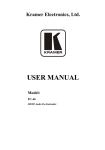Download Kramer Electronics VM-2DH video converter
Transcript
K R A ME R E LE CT R O N IC S L T D . USER MANUAL MODEL: VM-2DH DisplayPort to DVI/HDMI Converter P/N: 2900-300264 Rev 3 Contents 1 Introduction 1 2 2.1 2.2 Getting Started Achieving the Best Performance Recycling Kramer Products 2 2 3 3 3.1 4 4.1 Overview Defining the VM-2DH DisplayPort to DVI/HDMI Converter Connecting the VM-2DH Acquiring the EDID 4 5 6 7 5 Technical Specifications 9 Figures Figure 1: VM-2DH DisplayPort to DVI/HDMI Converter Figure 2: Connecting the VM-2DH DisplayPort to DVI/HDMI Converter U 5 6 U U U VM-2DH – Contents i 1 Introduction Welcome to Kramer Electronics! Since 1981, Kramer Electronics has been providing a world of unique, creative, and affordable solutions to the vast range of problems that confront video, audio, presentation, and broadcasting professionals on a daily basis. In recent years, we have redesigned and upgraded most of our line, making the best even better! Our 1,000-plus different models now appear in 11 groups that are clearly defined by function: GROUP 1: Distribution Amplifiers; GROUP 2: Switchers and Routers; GROUP 3: Control Systems; GROUP 4: Format/Standards Converters; GROUP 5: Range Extenders and Repeaters; GROUP 6: Specialty AV Products; GROUP 7: Scan Converters and Scalers; GROUP 8: Cables and Connectors; GROUP 9: Room Connectivity; GROUP 10: Accessories and Rack Adapters and GROUP 11: Sierra Products. Congratulations on purchasing your Kramer VM-2DH DisplayPort to DVI/HDMI Converter, which is ideal for the following typical applications: • Multiple screen applications • Rental and staging VM-2DH - Introduction 1 2 Getting Started We recommend that you: • Unpack the equipment carefully and save the original box and packaging materials for possible future shipment • Review the contents of this user manual i 2.1 Go to http://www.kramerelectronics.com to check for up-to-date user manuals, application programs, and to check if firmware upgrades are available (where appropriate). Achieving the Best Performance To achieve the best performance: • Use only good quality connection cables (we recommend Kramer highperformance, high-resolution cables) to avoid interference, deterioration in signal quality due to poor matching, and elevated noise levels (often associated with low quality cables) • Do not secure the cables in tight bundles or roll the slack into tight coils • Avoid interference from neighboring electrical appliances that may adversely influence signal quality • Position your Kramer VM-2DH away from moisture, excessive sunlight and dust ! ! 2 This equipment is to be used only inside a building. It may only be connected to other equipment that is installed inside a building. Caution: There are no operator serviceable parts inside the unit Warning: Use only the Kramer Electronics input power wall adapter that is provided with the unit Warning: Disconnect the power and unplug the unit from the wall before installing VM-2DH - Getting Started 2.2 Recycling Kramer Products The Waste Electrical and Electronic Equipment (WEEE) Directive 2002/96/EC aims to reduce the amount of WEEE sent for disposal to landfill or incineration by requiring it to be collected and recycled. To comply with the WEEE Directive, Kramer Electronics has made arrangements with the European Advanced Recycling Network (EARN) and will cover any costs of treatment, recycling and recovery of waste Kramer Electronics branded equipment on arrival at the EARN facility. For details of Kramer’s recycling arrangements in your particular country go to our recycling pages at http://www.kramerelectronics.com/support/recycling/. VM-2DH - Getting Started 3 3 Overview The Kramer VM-2DH is a DisplayPort to DVI/HDMI converter and distributor for digital signals that is HDCP (High-Bandwidth Digital Content Protection) compatible. Since high-resolution DVI signals are very sensitive to cable quality and to PCB layout, the VM-2DH uses a uniquely designed PCB which includes all buffering, conditioning and amplifying circuitry to provide two high-level output signals. In particular, the VM-2DH features: • Support for resolutions up to WUXGA, including all HDTV formats • A maximum data rate of 4.95Gbps (1.65Gbps per graphic channel) • The DDWG DVI 1.0 standard • Support for up to eight embedded audio channels • Built in re-clocking circuitry that regenerates the DVI/HDMI signal so that several units may be cascaded • A non-volatile read and store memory for the EDID (Extended Display Identification Data) block from one of the outputs, so it can then provide the EDID information to the DisplayPort source even if the display device is not connected • A default EDID for fast and efficient connection of the unit • I-EDIDPro™ Kramer Intelligent EDID Processing™—intelligent EDID handling and processing algorithm that ensures Plug and Play operation for DVI/HDMI systems • • A DVI-I connector which is compatible with all types of DVI cables State-of-the-art line drivers on both outputs to provide a cost-effective solution for distributing the TMDS signals used for DVI/HDMI 4 VM-2DH - Overview 3.1 Defining the VM-2DH DisplayPort to DVI/HDMI Converter This section defines the VM-2DH. Figure 1: VM-2DH DisplayPort to DVI/HDMI Converter # Feature 1 EDID SETUP Button Press to cycle through the EDID sources and to read the EDID (see Section 4.1) 2 IN LED Lights green when the input is active; flashes when the input is not valid 3 Function OUT DVI LED Lights green when a DVI acceptor output is connected 4 OUT HDMI LED Lights green when an HDMI acceptor is connected 5 ON LED Lights green when the unit is powered on 6 DP IN DisplayPort Connector Connect to the DisplayPort digital source 7 DVI OUT Connector Connect to the DVI acceptor 8 HDMI OUT Connector Connect to the HDMI acceptor 9 5V DC Connect to the 5V DC power adapter, center pin positive VM-2DH - Overview 5 4 Connecting the VM-2DH i Always switch off the power to each device before connecting it to your VM-2DH. After connecting your VM-2DH, connect its power and then switch on the power to each device. To connect the VM-2DH as illustrated in the example in Figure 2: 1. Connect a computer graphics DisplayPort source to the DP IN connector. 2. Connect the DVI OUT connector to the DVI projector. 3. Connect the HDMI OUT connector to the plasma display. 4. Connect the supplied 5V DC power adapter to the VM-2DH and to the mains electricity. 5. Optional—acquire the EDID (see Section 4.1). Figure 2: Connecting the VM-2DH DisplayPort to DVI/HDMI Converter 6 VM-2DH - Connecting the VM-2DH 4.1 Acquiring the EDID Initially the VM-2DH operates with the factory default EDID stored in the nonvolatile memory. The source reads the EDID from the device when the device is plugged in or powered on. This is usually done only once when the unit is being set up in an installation. Once acquired, the EDID is saved in non-volatile memory and further acquisition is not necessary. The VM-2DH reads the EDID, which is stored in the non-volatile memory The VM-2DH provides the ability to acquire the EDID from: • • One output (the relevant output LED lights) Two connected outputs in Auto-Mix mode (both output LEDs are lit) The EDID acquired is a weighted average of all the connected outputs. For example, if several displays with different resolutions are connected to the outputs, the acquired EDID supports all the resolutions, as well as other parameters included in the EDID. • The initial, default EDID (both output LEDs flash) Pressing the EDID button briefly causes the output LEDs to indicate the source of the EDID that was last acquired. If the: • HDMI OUT LED lights, the HDMI OUT EDID was stored • DVI OUT LED lights, the DVI OUT EDID was stored • Both OUT LEDs light, the Auto-Mix EDID was stored • Both OUT LEDs flash, the default EDID is stored To acquire the EDID: 1. Connect the power. 2. Connect the output(s) from which you want to acquire the EDID. 3. Press and hold the EDID button to select the desired EDID source. The OUTPUT LEDs light in the following cycle: HDMI OUT DVI OUT Both LEDS (Auto-Mix) VM-2DH - Connecting the VM-2DH 7 Both LEDs flash (default) 4. Release the button when reaching the desired EDID source. The EDID is acquired. If you set the machine to acquire the EDID from an output that is not connected, the default EDID is acquired. 8 VM-2DH - Connecting the VM-2DH 5 Technical Specifications INPUT: 1 DisplayPort connector OUTPUTS: 1 DVI, 1.2Vpp on a DVI Molex 24-pin female connector; DDC signal 5Vpp (TTL); 1 HDMI connector STANDARDS COMPLIANCE: Supports DVI 1.1, HDCP and HDMI MAX RESOLUTION: Up to WUXGA (1920x1200), 1080p BANDWIDTH: 4.95Gbps (1.65Gbps per graphic channel) CONTROLS: EDID button for selecting and storing EDID information POWER SOURCE: 5V DC, 800mA OPERATING TEMPERATURE: 0° to +40°C (32° to 104°F) STORAGE TEMPERATURE: -40° to +70°C (-40° to 158°F) HUMIDITY: 10% to 90%, RHL non-condensing DIMENSIONS: 12cm x 7.2cm x 2.4cm (4.7" x 2.8" x 1.0") W, D, H WEIGHT: 0.3kg (0.67lbs) approx. ACCESSORIES: Power supply, mounting bracket OPTIONS: RK-3T rack adapter Specifications are subject to change without notice at http://www.kramerelectronics.com VM-2DH - Technical Specifications 9 10 VM-2DH - Technical Specifications For the latest information on our products and a list of Kramer distributors, visit our Web site where updates to this user manual may be found. We welcome your questions, comments, and feedback. Web site: www.kramerelectronics.com E-mail: [email protected] ! P/N: SAFETY WARNING Disconnect the unit from the power supply before opening and servicing 2900- 300264 Rev: 3
























